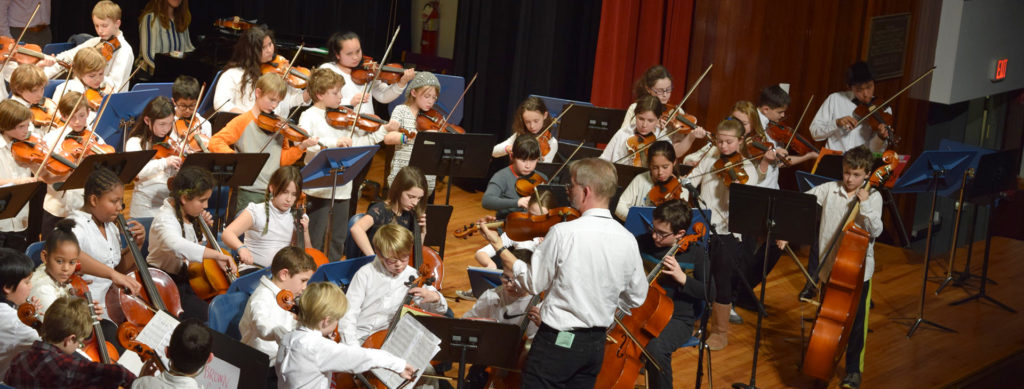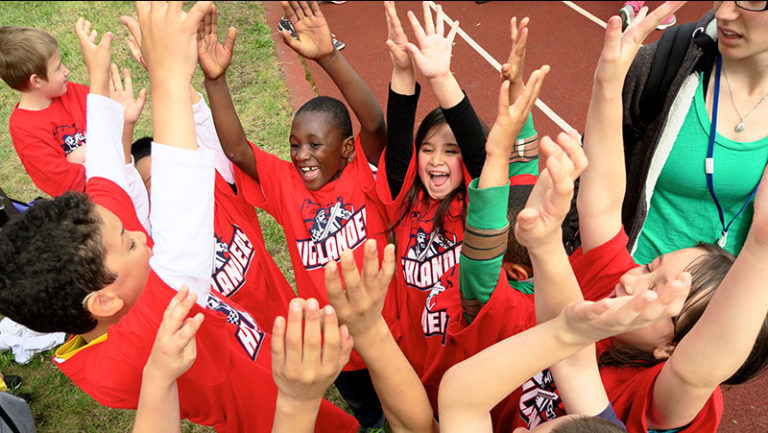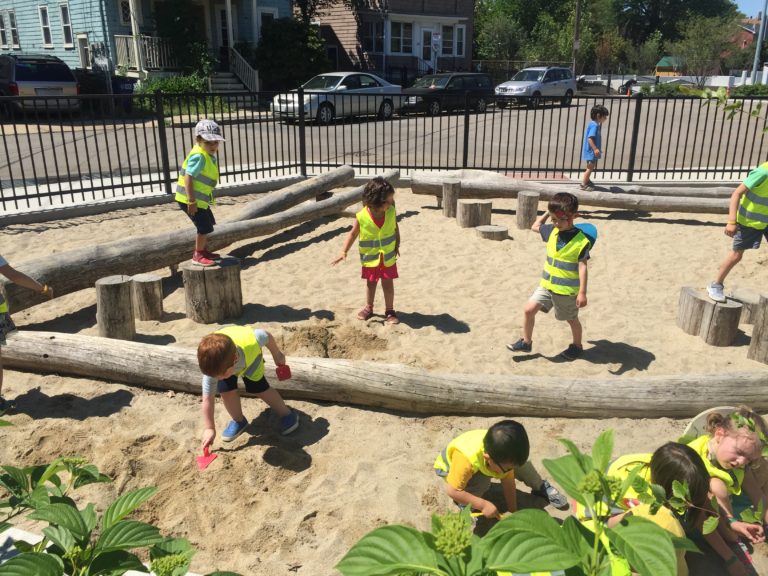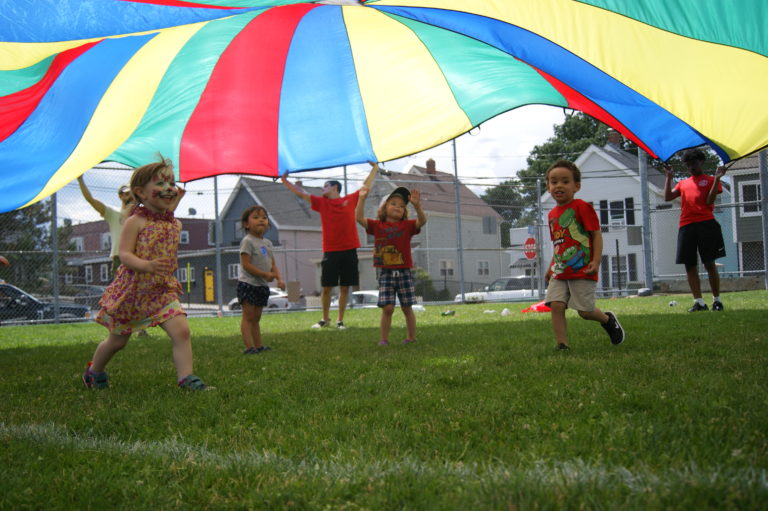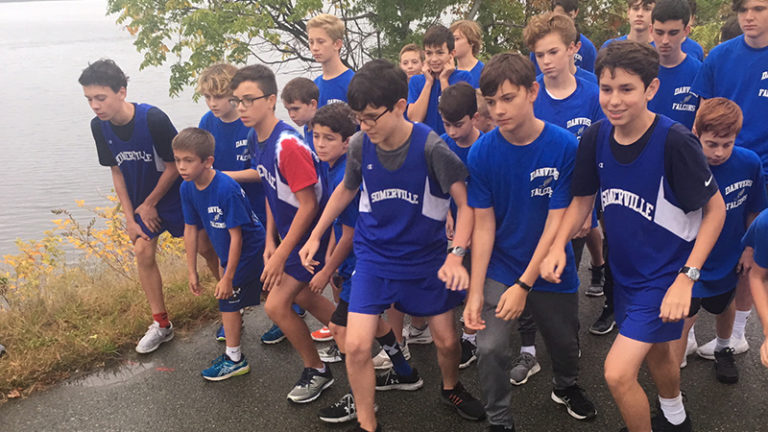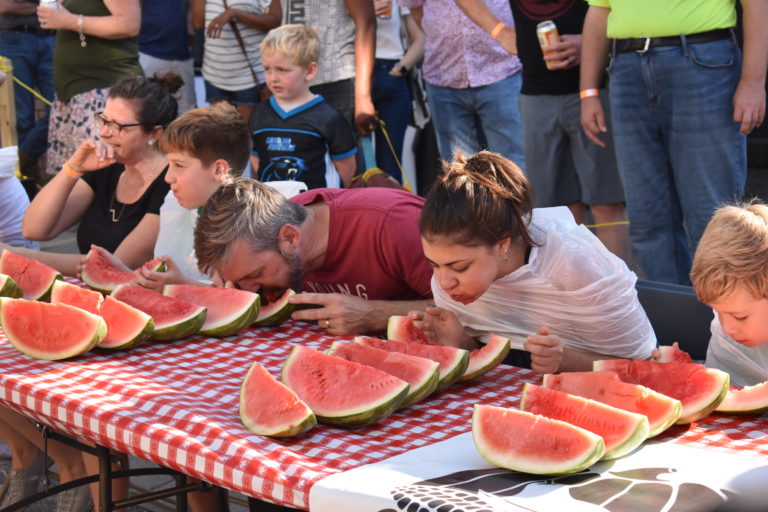SomerVision Number
OF YOUTH ON A PATH TO COLLEGE, CAREER, LIFE
in perpetuity by 2040
The scope for the Youth and Education topic chapter is: Children (birth through teenagers), public schools, out of school learning, childcare.
The Somerville Children’s Cabinet was formed in 2017 with the support of the By All Means initiative of the Education Redesign Lab at Harvard Graduate School of Education. The Cabinet shares the aim of the By All Means Initiative: to develop comprehensive child wellbeing and education systems that help eliminate the link between children’s socioeconomic status and achievement. Members of the community, City staff, and Somerville Public Schools staff all sit on on the Children’s Cabinet.
Another strength is the Somerville Parks & Recreation Department, which operates year-round programs throughout the City’s public facilities, playgrounds, schoolyards, and other locations to promote positive and healthy activities for all members of the Somerville community. A new, accessible, modern facility for the many services the department provides will make it more successful in providing its existing services for toddlers to middle schoolers and its workforce development program for older youth.
This chapter of SomerVision is substantially influenced by the Somerville Learning 2030 (SL2030) process. This effort is a strength in and of itself and represents a collaboration between the City of Somerville, Somerville Public Schools (SPS), city youth organizations, youth leaders, and residents. Over a period of eight months, a diverse steering committee of Somerville residents and leadership, supported by a nonprofit consulting firm, conducted community surveys and listening sessions to collect data about the current offerings for youth in the city and opportunities for improvement. The full report is available at www.somervillema.gov/childrenscabinet, under Resources and Tools. This topic chapter captures many of the insights highlighted in the report. In addition, additional perspective and ideas from the SomerVision process, including the Youth and Education working group, SomerSuppers that discussed youth and their issues, and a specific youth forum co-organized with resident teenagers.
STRENGTHS
There is a lot to be excited about regarding youth and education in Somerville. The centerpiece of this optimism is Somerville Public Schools. The City has increased its investment in the school district 70% over 15 years, and this commitment to and investment in education has led SPS to emerge as one of the most innovative urban school districts in the Commonwealth. A key example of this investment is the new Somerville High School. In 2016, 72% of voters supported the new 1,590-student high school project thatis expected to open in fall 2021. This willingness to invest in Somerville’s educational system demonstrates a shared interest in supporting the community’s youth. Community feedback indicates that a lot of other things are going well for Somerville youth learning and wellness. Families are thrilled with the plethora of family-friendly resources, including street festivals, excellent playgrounds and schoolyards, and shared playgroups, as well as the existing educational and afterschool programs. The bilingual/bicultural Unidos program, Career and Technical Education program, and youth leadership and employment opportunities were all cited as particularly positive examples.Somerville’s school district continues to see strong enrollment trends, particularly in our elementary-age population. Like the city as a whole, the district’s strength is in our diversity; our students are 41% Latino; 38% White; 10% African American; and 11% Asian or mixed race. Half of our students speak a primary language other than English; approximately 20% are Special Needs; 20% are English Learners and 60% are economically disadvantaged.
Somerville Public Schools continues to have a strong reputation locally and across the Commonwealth for the quality education we provide, our focus on the whole child, our passion for innovation and improvement, the depth and quality of our Arts and Music programming, and for continuing to be one of the highest performing urban districts year after year. SPS is also gaining increasing notice across New England for its bold approach to redesigning its educational model and approach to ensure that all students are prepared for a rapidly changing world. SPS has achieved its highest graduation rate and lowest dropout rate in its history. We also have the greatest number of Somerville High School students ever taking college-level courses. Currently, over 400 SHS students enroll in more than 700 Advanced Placement courses each year.
In partnership with the City and the Somerville community, the Children’s Cabinet is continuing our work as a founding member of the Harvard Education Redesign Lab’s By All Means initiative. The initiative looks at ways that we can work together as a community to develop a comprehensive child wellbeing and education system to eliminate the link between a child’s socioeconomic status and academic achievement. Working together and in concert with other communities across the United States committed to leveling the playing field, Somerville is finding ways to leverage its resources and passion to remove barriers and eliminate opportunity gaps.
A key focus of By All Means has been strengthening extended learning opportunities, particularly for students of color and older students who have been traditionally underrepresented in afterschool and summer learning programs in the city. Somerville has partnered with leading providers including Citizen Schools, Breakthrough, Calculus Project, Enroot, and Boston Debate League to offer a menu of extended learning options for youth. The City’s Parks & Recreation department provides additional opportunities for activity and learning for the community, offering well over a hundred different programs for children each year and serving thousands of families.
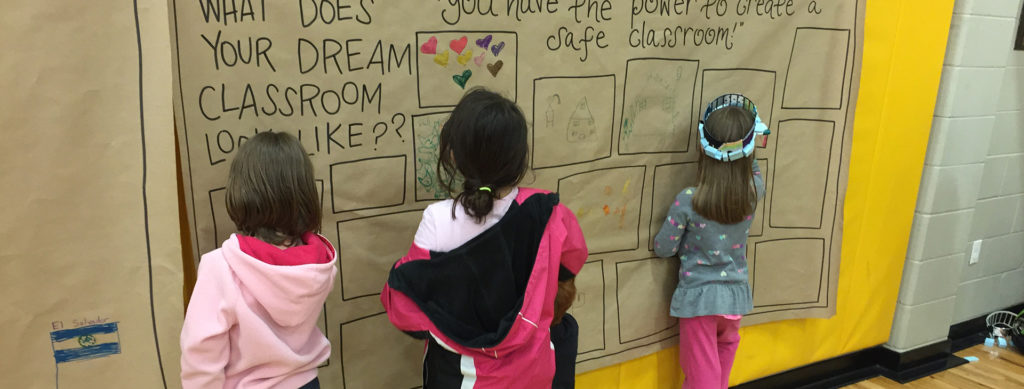
OPPORTUNITIES & CHALLENGES
Many of SL2030 and SomerVision participants expressed a priority for continuing our community’s investment in families and youth.High housing costs and competition for family-sized units makes it difficult for families with children to move to or remain in Somerville. Many SomerVision participants mentioned anecdotes about illegal housing discrimination against children, when landlords avoid renting to families. These housing challenges have a rippling effect throughout the community as children are displaced from their social networks, existing communities are disrupted, and homelessness increases. A recent youth forum highlighted the lack of information and resources for low-income and immigrant families regarding tenant rights, after school options, and support for post-secondary opportunities. Youth saw a need for more outreach to these families about the many resources available. Another major challenge that emerged was around the availability and cost of early childcare. Childcare options that support the needs of working family schedules and budgets seem to be in short supply, with participants reporting limited slots and hours, waitlists, high costs, inconvenient locations, and staffing issues. Although afterschool programs are plentiful and often affordable, some expressed concern that high demand for these programs might prevent equitable access to these resources. Additionally, these after school programs tend to windle as kids age; middle schoolers age out of traditional afterschool programs but are not ready for complete independence.One consistent piece of feedback was the need to explore opportunities for adding recreational and community space. The Boys & Girls Clubs of Medford and Somerville (BGCMS) closed in September 2018, leaving behind a gap in unstructured space and services for Somerville youth. Both the YMCA and the City’s Parks and Recreation department provide a variety of classes, activities, and resources as well, but both would benefit from more accessible, functional, modern facilities and program space.
Numerous conversations with youth confirmed that the many local festivals and events in Somerville highlight and celebrate the diversity of our neighborhoods. They appreciate the open spaces and parks, many of which have been updated. Youth appreciate the organizations focused on their age group, such as Teen Empowerment and the school department after school offerings such as Citizen Schools and Breakthrough. Many young people take advantage of the Teen Room at the main branch library. They generally appreciate the care and support of teachers at the K-8 schools and Somerville High. The art, music, and social studies programs were particularly mentioned for their inclusiveness and for helping students after school. Youth also feel that the SHS staff have supported students’ voice and organizing in speaking out against gun violence and other critical issues. Young people in the youth forum also emphasized the importance of preserving small businesses for their character and unique value they provide to the neighborhoods. They appreciate the farmers markets and school and community gardens. Regarding the school system specifically, community members are interested in seeing more emphasis on learning through play and projects for elementary school-age children, as well as more time for physical movement and breaks. For tweens and middle schoolers, there is an interest in putting more emphasis on personal growth and social-emotional support as well as more academic efforts. This theme evolved for the older students as SL2030 respondents, in particular, cited an interest in more flexible approaches to learning in high school and assistance in learning “real life” skills. In addition, participants wondered about methods to improve access to information and meetings. In particular, there might need to be additional resources or support for helping recent immigrants to not only stay informed but to participate meaningfully in the community.
The youth forum highlighted additional challenges students face at the high school related to the needs of low income students, immigrant students and students of color and adequate access to information on postsecondary options and guidance. They felt that more guidance personnel arenecessary, along with more teachers and counselors of color who could better understand students’ day-to-day experience. Another challenge identified in our outreach to youth was concerns about racial equity in the school system. Specifically, teenagers discussed how teachers are responsible for recommending what level of class a student takes and wondered if fewer students of color were ending up in advanced placement or honors classes than their white peers. Furthermore, students of color are more likely to drop out of school. SPS has already put a variety of resources into monitoring attendance – low attendance can be an early indicator for a student dropping out – but additional work will be needed to address the disproportionate numbers. The achievement gap is a challenge that nearly every school district in America faces. There are no easy answers, but Somerville must remain committed to addressing racial and ethnic inequity in our schools.Finally, communication related to resources for youth remains a challenge. Adequately promoting and sharing the many resources available to families is bound to be a challenge, but ensuring that all families have equal access to information and services is particularly important. This includes everything from facilitating interpretation between teachers and parents to promoting available programs and their accessibility, to ensuring that meetings are scheduled in a way that maximizes involvement.
OPPORTUNITIES & CHALLENGES
Many of SL2030 and SomerVision participants expressed a priority for continuing our community’s investment in families and youth.High housing costs and competition for family-sized units makes it difficult for families with children to move to or remain in Somerville. Many SomerVision participants mentioned anecdotes about illegal housing discrimination against children, when landlords avoid renting to families. These housing challenges have a rippling effect throughout the community as children are displaced from their social networks, existing communities are disrupted, and homelessness increases. A recent youth forum highlighted the lack of information and resources for low-income and immigrant families regarding tenant rights, after school options, and support for post-secondary opportunities. Youth saw a need for more outreach to these families about the many resources available. Another major challenge that emerged was around the availability and cost of early childcare. Childcare options that support the needs of working family schedules and budgets seem to be in short supply, with participants reporting limited slots and hours, waitlists, high costs, inconvenient locations, and staffing issues. Although afterschool programs are plentiful and often affordable, some expressed concern that high demand for these programs might prevent equitable access to these resources. Additionally, these after school programs tend to windle as kids age; middle schoolers age out of traditional afterschool programs but are not ready for complete independence.One consistent piece of feedback was the need to explore opportunities for adding recreational and community space. The Boys & Girls Clubs of Medford and Somerville (BGCMS) closed in September 2018, leaving behind a gap in unstructured space and services for Somerville youth. Both the YMCA and the City’s Parks and Recreation department provide a variety of classes, activities, and resources as well, but both would benefit from more accessible, functional, modern facilities and program space.
Numerous conversations with youth confirmed that the many local festivals and events in Somerville highlight and celebrate the diversity of our neighborhoods. They appreciate the open spaces and parks, many of which have been updated. Youth appreciate the organizations focused on their age group, such as Teen Empowerment and the school department after school offerings such as Citizen Schools and Breakthrough. Many young people take advantage of the Teen Room at the main branch library. They generally appreciate the care and support of teachers at the K-8 schools and Somerville High. The art, music, and social studies programs were particularly mentioned for their inclusiveness and for helping students after school. Youth also feel that the SHS staff have supported students’ voice and organizing in speaking out against gun violence and other critical issues. Young people in the youth forum also emphasized the importance of preserving small businesses for their character and unique value they provide to the neighborhoods. They appreciate the farmers markets and school and community gardens. Regarding the school system specifically, community members are interested in seeing more emphasis on learning through play and projects for elementary school-age children, as well as more time for physical movement and breaks. For tweens and middle schoolers, there is an interest in putting more emphasis on personal growth and social-emotional support as well as more academic efforts. This theme evolved for the older students as SL2030 respondents, in particular, cited an interest in more flexible approaches to learning in high school and assistance in learning “real life” skills. In addition, participants wondered about methods to improve access to information and meetings. In particular, there might need to be additional resources or support for helping recent immigrants to not only stay informed but to participate meaningfully in the community.The youth forum highlighted additional challenges students face at the high school related to the needs of low income students, immigrant students and students of color and adequate access to information on postsecondary options and guidance. They felt that more guidance personnel arenecessary, along with more teachers and counselors of color who could better understand students’ day-to-day experience. Another challenge identified in our outreach to youth was concerns about racial equity in the school system. Specifically, teenagers discussed how teachers are responsible for recommending what level of class a student takes and wondered if fewer students of color were ending up in advanced placement or honors classes than their white peers. Furthermore, students of color are more likely to drop out of school. SPS has already put a variety of resources into monitoring attendance – low attendance can be an early indicator for a student dropping out – but additional work will be needed to address the disproportionate numbers. The achievement gap is a challenge that nearly every school district in America faces. There are no easy answers, but Somerville must remain committed to addressing racial and ethnic inequity in our schools.Finally, communication related to resources for youth remains a challenge. Adequately promoting and sharing the many resources available to families is bound to be a challenge, but ensuring that all families have equal access to information and services is particularly important. This includes everything from facilitating interpretation between teachers and parents to promoting available programs and their accessibility, to ensuring that meetings are scheduled in a way that maximizes involvement.

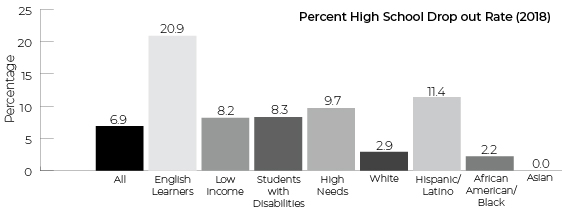
GOALS AND TAKEAWAYS
Look beyond the school system to support Somerville’s youth. The challenges our children and school system are facing are not isolated to the public school system. Issues related to housing, workforce development, and community engagement all affect the daily lives of students. As a result, school district staff should consider opportunities to participate in nonprofits and coalitions around these important, cross-cutting topics.Support the development of a youth center. A center for older youth via a collaboration between the City, Somerville Public Schools, and other non profit agencies is needed. A youth board should lead the way in the development and organization of such a center with adults providing support, and help with funding and advisory support and supervision. Provide affordable, high-quality childcare and afterschool programming. Childcare to all families, with options for all age groups is important. This helps all families, but forum participants also explained that a lack of childcare access is one of the biggest barriers preventing immigrants from taking English and professional training classes.Embrace a citywide approach to equity and diversity in the school system. Because research shows that all children benefit from a highly skilled and diverse educator workforce that reflects SPS students and families, we must continue to increase our staff of color and staff with multiple language capacity Consider growth and changing demographics in the city. As more housing is developed in Somerville, nonprofits, schools, and other community institutions should consider how these additional residents will affect their staffing needs and capacity.Prioritize play-based learning and hands-on projects that build academic, real-world, and personal skills. Emphasize relevant, deeper learning – enhanced by experiences that take place outside of the classroom or in collaboration with community experts, colleges, and other resources. Introduce flexible scheduling at the high school. Increase access to internships, work-based learning experiences, and youth employment. This should ideally include additional opportunities for youth to participate in city leadership bodies and decision-making processes.Provide comprehensive social-emotional wellness and mental health support. Ensure strong access to social-emotional wellness and mental health supports at school and in the community, with a particular focus on racial, ethnic, and socioeconomic equity.
EQUITY GOALS
Support immigrants to access resources and participate in community life. Participants at one of the Portuguese-language forums said that the community already did a great job supporting new Portuguese-speaking families, but SL2030 participants, students, and other stakeholders identified information access as an opportunity for improvement. Although communication to all families is important, ensuring that translation, interpretation, and extra outreach services reach all non-native English speakers to be effective.
Minimize the achievement gap in Somerville schools. The racial achievement gap is a difficult, multifaceted challenge with no singular solution, but it must remain a priority for everyone working with youth and the educational system in our community
POTENTIAL TASKS
- Establish a cross-cutting task force to explore how to better communicate resources and information to all families. This can include exploration of a common application or registration system that would make it easier for people to apply to multiple programs with only one application.
- Ensure all SPS schools are true community schools with integrated academic, health and social services, youth development, and community supports.
- Explore opportunities to create new gathering spaces for youth in the city. Ensure Somerville has at least one active recreation or youth center accessible for all youth.
- Create a Parks & Recreation facility to host programming, community events, and offices. An accessible, modern facility will support existing programs and serve as a a place for all ages, backgrounds, and interests to come together and connect.
- Provide strong, collaborative Grade 8 to Grade 9 transition support to every SPS student.
- Find more funds to support paid and unpaid internships and apprenticeships for middle and high school students to help them feel more empowered.
- Research with the intent to implement a later high school start time. Engage parents and youth to discuss the pros and cons of a later schedule.
- Explore how to provide affordable early learning and care programs to all Somerville families. This effort should consider a City-run or City-supported child care program, a babysitting cooperative in conjunction with the high school, and a program at the Visiting Nurses Association that let the elderly engage with children.
- As part of kindergarten readiness, support social-emotional skill development and screen every child for behavioral health, and early learning issues.
- Establish an immigrant student committee and find additional ways to incorporate more student voice onthe Somerville School Committee.
- Use a collaborative process involving parents, educators, and students to review elementary homework policies. Develop a thoughtful, research-informed homework policy focused on student success in school and beyond.
- Expand access to afterschool, summer, and dual-language programs to additional schools.
- Somerville Learning 2030 members and others can form a “Somerville Learning Task Force” that includes representatives of all organizations serving youth with learning opportunities (i.e. schools, community organizations, early childhood centers, industry partners, etc.) to prioritize the report’s recommendations and help inform how each stakeholder group can incorporate them into their work.
